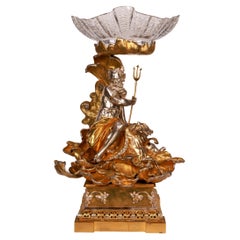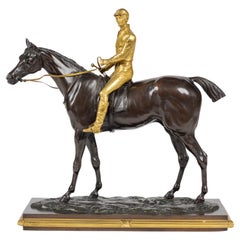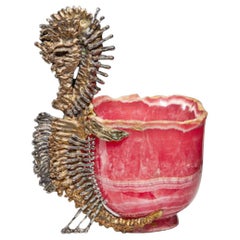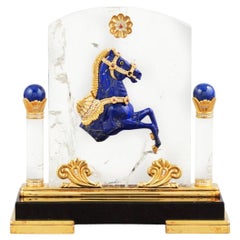Want more images or videos?
Request additional images or videos from the seller
1 of 21
Francois-Raoul Larche a French Gilt Bronze Table Centerpiece
$25,000List Price
About the Item
- Creator:François-Raoul Larche (Sculptor)
- Dimensions:Height: 6.5 in (16.51 cm)Width: 19 in (48.26 cm)Depth: 10 in (25.4 cm)
- Style:Art Nouveau (Of the Period)
- Materials and Techniques:
- Place of Origin:
- Period:
- Date of Manufacture:circa 1900
- Condition:Wear consistent with age and use.
- Seller Location:Queens, NY
- Reference Number:1stDibs: LU1798222365092
About the Seller
5.0
Vetted Professional Seller
Every seller passes strict standards for authenticity and reliability
Established in 1980
1stDibs seller since 2016
63 sales on 1stDibs
Typical response time: 1 hour
Authenticity Guarantee
In the unlikely event there’s an issue with an item’s authenticity, contact us within 1 year for a full refund. DetailsMoney-Back Guarantee
If your item is not as described, is damaged in transit, or does not arrive, contact us within 7 days for a full refund. Details24-Hour Cancellation
You have a 24-hour grace period in which to reconsider your purchase, with no questions asked.Vetted Professional Sellers
Our world-class sellers must adhere to strict standards for service and quality, maintaining the integrity of our listings.Price-Match Guarantee
If you find that a seller listed the same item for a lower price elsewhere, we’ll match it.Trusted Global Delivery
Our best-in-class carrier network provides specialized shipping options worldwide, including custom delivery.You May Also Like
'Cupid & Psyche' an Important Bronze Figure by François-Raoul Larche
By François-Raoul Larche
Located in Brighton, West Sussex
'Cupid & Psyche' - An important parcel-gilt and patinated bronze figure, by François-Raoul Larche.
Signed to the base 'Raoul Larche 1891'.
This finely cast parcel-gilt bronze figure depicts Cupid and Psyche with Zephyr.
François-Raoul Larche (1860-1912), the son of an ornamental sculptor, was a well-known Art Nouveau sculptor...
Category
Antique 19th Century French Figurative Sculptures
Materials
Bronze
$12,399
H 27.96 in W 18.51 in D 13 in
Francois Raoul Larche (1860-1912) LA SEVE or Métamorphose de Daphné
By François-Raoul Larche
Located in Dallas, TX
Francois Raoul Larche (1860-1912) LA SEVE or Métamorphose de Daphné Gilt Bronze Art Nouveau Sculpture
Cast, Gilt Bronze or Marble base
France, c. 1900,
Signed "Raoul Larche," number...
Category
Antique Early 1900s French Art Nouveau Figurative Sculptures
Materials
Bronze
23” Raoul Larche 'L'Idée, Allégorie sur un Rocher' Gilt Bronze Inkwell
By François-Raoul Larche
Located in Dallas, TX
Raoul Larche (1860-1912) Monumental Inwell vide pouch.
'L'Idée, Allégorie sur un Rocher' A Gilt-Bronze Inkwell, circa 1900
Figural Centerpiece, Inkwell and vide pouch.
Gilt-bronze
H...
Category
Vintage 1910s French Art Nouveau Figurative Sculptures
Materials
Bronze
$18,000
H 19 in W 23 in D 18 in
Raoul Fançois Larche Patinated Bronze Figure of a woman
By François-Raoul Larche
Located in West Palm Beach, FL
Raoul François Larche (1860-1912)
A lovely patinated bronze figure of a young woman standing barefooted on a circular mounted base and gazing up...
Category
20th Century Figurative Sculptures
Materials
Bronze
Raoul Larche: bronze sculpture of Jeanne d'Arc
By François-Raoul Larche
Located in Zemst, BE
Impressive bronze sculpture by french artist François-Raoul Larche (1860-1912).
Representing Jeanne d'Arc
Dated: +/- 1900
High quality bronze finished a in double colour patina.
...
Category
Early 20th Century French Neoclassical Figurative Sculptures
Materials
Bronze
Francois-Raoul Larche Bronze Sculpture La Tempête et les Nuées
Located in New York, US
Our important bronze by Francois-Raoul Larche (1860-1912), cast circa 1905, is entitled La Tempête et les Nuées (The Storm and the Clouds). Signed RAOUL. LARCHE and stamped with the ...
Category
Early 20th Century French Neoclassical Revival Figurative Sculptures
Materials
Bronze
Raul Larche Bronze Cast Siot Decaville
By François-Raoul Larche
Located in Buenos Aires, Argentina
Raul Larche bronze cast Siot Decaville
Raul Larche 1860-1912
Title: The 20 years
golden patina natural wear.
Category
Antique Early 1900s Neoclassical Figurative Sculptures
Materials
Bronze
French Antique Gilt Bronze and Nacre Trinket Dish, 19th Century
Located in Miami, FL
Intricate French gilt bronze work depicting lovebirds sharing a worm above a pearl egg nest upon a tree, while a cobra nestles at the tree base. The work is ...
Category
Antique 19th Century Art Nouveau Garniture
Materials
Bronze
Antique French Grand Tour Ormolu Bronze Dore Marble Urn Vase Centerpiece 19thC
By Claude Michel Clodion
Located in Dublin, Ireland
Superb Example of French lidded grand tour ormolu & bronze cast heavy duty model of a two handled Urn of Museum quality. First quarter of the Nineteenth Century, possibly Regency per...
Category
Antique Early 19th Century French Regency Urns
Materials
Siena Marble, Bronze, Ormolu
$2,256
H 14.5 in W 8 in D 5.75 in
Antique Second Empire French Doré Gilt Bronze Vases or Urns
Located in Philadelphia, PA
A fine pair of antique French gilt bronze vases.
Decorated with an assembly of musical instruments, a gourd, and even a hat.
Extremely solid and finely cast, these urns or vas...
Category
Antique Late 19th Century French Empire Revival Vases
Materials
Bronze
More From This Seller
View AllMonumental Silvered and Gilt-Bronze Glass Centerpiece of "Poseidon"
Located in Queens, NY
A Monumental French Silvered and Gilt-Bronze and Glass Centerpiece of "Poseidon", Paris, circa 1895.
A very good quality centerpiece depicting "Poseidon and his seahorses", of mon...
Category
Early 20th Century French Classical Greek Centerpieces
Materials
Bronze
Isidore-Jules Bonheur, A Rare Gilt and Patinated Bronze Jockey on A Horse
By Isidore Jules Bonheur
Located in Queens, NY
Isidore-Jules Bonheur (French, 1827–1901)
A Rare Gilt and Patinated Bronze Jockey on A Horse, circa 1875.
Introducing a truly exceptional and highly s...
Category
Antique 19th Century French Sporting Art Animal Sculptures
Materials
Bronze
Chaumet Paris, a French Silver-Gilt Seahorse Mounted Rhodochrosite Cup
By Chaumet
Located in Queens, NY
Chaumet Paris, A French Silver-Gilt Seahorse Mounted Rhodochrosite cup
Circa 1980.
An exceptional object
A quadrangular cut cup in rhodochrosite and the handle made of a sea...
Category
Late 20th Century French Brutalist Mounted Objects
Materials
Sterling Silver
Mellerio Paris, A French Gold, Diamond, Silver-Gilt, Rock-Crystal, & Lapis Horse
By Mellerio
Located in Queens, NY
Mellerio Paris, A French Gold, Diamond, Silver-Gilt, Rock-Crystal, Obsidian & Lapis Horse
An extremely rare and unique, one of a kind French gold, diamonds, Silver-gilt rock-crystal, obsidian and lapis lazuli jeweled sculpture "Bucéphale, Chevaux de légende", "Bucephalus, A Legendary Horse" by Mellerio, Paris, circa 1998.
Sitting on black obsidian base, the solid rock crystal slab is finely applied with a lapis lazuli half-horse with harness mounted in 18k gold and brilliant cut diamonds, between two crystal and lapis lazuli columns adorned with gold and diamonds, insert with 7 ruby cabochons and 1 emerald cabochon, the obsidian base with a plaque engraved: CHEVAUX DE LEGENDE / MELLERIO DITS MELLER / PARIS / 5029 DIV
Bucephalus (c355-326 BC) is among the most famous horses in history, and it was said that this he could not be tamed. The young Alexander the Great, of course, tamed him – and went on to ride his beloved equine companion for many years and into many battles.
The piece is in excellent condition and comes with a custom made wood case made for transport. It's very elegant and has French hallmarks throughout. A truly magnificent piece.
Measures 10" high x 9" wide x 4" deep
Founded in France in 1613 by the descendants of Italian immigrants from the Vigezzo Valley in the north of Italy, Mellerio is one of the oldest jewellery houses in Europe. The family business soon attracted the attention of the Royal Court and Marie Antoinette herself reportedly purchased a precious bracelet featuring 7 cameos surrounded by rubies in 1780. Later on, in the 19th century, Mellerio became the official supplier of the French Royal family and the Court of Netherland.
Mellerio creates many jewellery items, all set with rare gems such as peridots, amethysts, aquamarines, citrines and topaz, applying for a patent, the flexible stem, a very supple and light jewellery mechanism. Mellerio remains also well known for their spectacular series of Art Nouveau jewels, created at the beginning of the 20th century, as well as for the creation of trophies rewarding some of the greatest footfall and tennis players of history. In 1993, the jewellery house launched their first watch collection.
Today, Mellerio has stores in Paris, Japan and Hong Kong.
July 14, 1789: this date is known throughout the world as the beginning of the French Revolution. According to a ledger belonging to House of Mellerio, this was also the day that the jeweler sold a golden key to the Comte de Coutance for 10 livres. This ledger, as well as inventories dating as far back as 1768, are the jeweler’s oldest archives. These archives have continued to grow over the years, as the House, established on rue de la Paix in Paris, still lives on today, still in the hands of the same family from Craveggia, in the North of Italy.
The tumultuous history of the Mellerio family in France probably goes as far back as the Italian wars of the Renaissance, but the first official document proving their commercial activity in Paris dates back to 1613. This document is the famous royal warrant awarded by Marie de Medici to a number of Italian families established along the rue des Lombards, including the Mellerios, allowing them to sell “small jewelery items”, therefore granting them a small exception to the traditional monopoly enjoyed by Parisian jewelers. At that time, powerful corporations regulated the operations and customs of Parisian business, but thanks to this exceptional warrant, the Mellerios managed to escape the confines of this framework. Today, this wax-sealed document is kept at the city hall of Craveggia.
From 1613 to the Revolution, the Mellerios lived between France and Italy. The corporations tried many times to put an end to their trade privileges, but all in vain, as a dynasty of sovereigns renewed the warrant. Always marrying and often retiring in Craveggia, the Mellerios continued to maintain their jewelry business in Paris. At first, they did this without a shop. Wearing backpacks (wooden boxes divided into small compartments where jewels were kept), they would tour town fairs around Paris and royal castles.
This is how Jean-Baptiste Mellerio (1765-1850) is said to have sold a bracelet set with rubies and Antique cameos to Marie-Antoinette, which still exists today. Many elements seem to prove the veracity of this anecdote. The queen was particularly fond of cameos, which cover the entire background of her famous jewelry cabinet, and ruby was her favorite stone after diamond. The famous bracelet, reacquired a few years ago by the House of Mellerio, is indeed an 18th century jewel, set with antique cameos representing the profiles of Roman emperors. Two branches of the family were operating in Paris during this time, under the reign of Louis XVI: that of Jean-François (1746-1828), the paternal ancestor of the current Mellerios, and that of Jean-Baptiste (1765-1850).
The French Revolution forced them to return to Italy. However, both Jean-Baptiste and François Mellerio (1772-1843), who was the son of Jean-François, were eventually able to return to Paris after the founding of the Consulate. Jean-Baptiste opened a shop at the Iron Crown of rue Vivienne, and François opened his at the Palais des Tuileries, rue du Coq Saint-Honoré. His well-organized order books give an idea of his high-ranking clientele during the “Old Regime”, among which were the Comte and Comtesse Octave de Segur, the Marquise (later Duchess) de Tourzel, former governess of the royal children, and her daughter, the Comtesse de Bearn, the Craufurds -who organized the flight to Varennes, the Duc and Duchess de Gramont, the Comtesse de Boigne, and Madame de Souza, Talleyrand’s mistress.
We also see the names of the imperial family: Empress Josephine, the Queen of Holland, Princess Elisa, Caroline and Pauline. At that time, the House of Mellerio specialized, among other things, in the trade of antique cameos, a newly fashionable genre of jewel that captured the imagination of all the princesses and noble women of the time.
The years of the Restauration and July Monarchy were among the most glorious. The Bourbons were back on the throne, and the clientele of the House of Mellerio had regained its former wealth. Mellerio supplied Louis-Philippe, Duke of Orléans, as well as his mother, wife and sister, with sumptuous jewels, including a set of emeralds made piece by piece, while the Duke of Bourbon, last prince of the House of Condé, offered diamonds to his mistress, the scheming Baronne de Feucheres, and Monsieur de LaFayette also bought cameos for one of his granddaughters. For the first time, Mellerio ventured into the world of arts in 1815, when Carlotta Grisi, a famous dancer who created Giselle, as well as an actress named Rachel, bought jewels at the Mellerio store on rue de la Paix.
1848 marked a new turning point. France once again became a Republic. François Mellerio handed the company over to his son, Jean, and the latter decided to travel to Spain to build a new clientele. He later became one of the jewelers of the royal family, and met Eugénie de Montijo, who remained a faithful client when she became empress of the French people. The Imperial years were lavish. During the Second Empire, Paris was a pageant of crinoline dresses designed by Worth, while jewels by Mellerio, Worth’s neighbour on the rue de la Paix, adorned the noble women of the Tuileries court.
The Empress bought pearls. Mathilde Bonaparte...
Category
20th Century French Mounted Objects
Materials
Lapis Lazuli, Rock Crystal, Gold, Silver
Monumental French Patinated Bronze Bust of William Shakespeare, After Houdon
By F. Barbedienne Foundry
Located in Queens, NY
A monumental French patinated bronze bust of William Shakespeare, after Houdon, by F. Barbedienne Foundry, circa 1870.
Masterfully and realistically sculpted in solid bronze, this...
Category
Antique 19th Century French Napoleon III Busts
Materials
Bronze
1876 Centennial Exhibition, J & L. Lobmeyr Ormolu Mounted Ruby Glass Centerpiece
By J. & L. Lobmeyr Company
Located in Queens, NY
1876 Centennial Exhibition, J & L. Lobmeyr Exceptional Ormolu Mounted Bohemian Ruby Glass Centerpiece
This exceptional Bohemian ruby red glass centerpiece, by he renowned Viennese glass manufacturer J. & L. Lobmeyr, exemplifies the firm's mastery in combining classical aesthetics with innovative design. Created circa 1876, this piece was showcased at the Centennial International Exhibition in Philadelphia, reflecting the era's fascination with classical motifs and superior craftsmanship.
The centerpiece adopts a form inspired by admired Greek patterns, characterized by its elegant proportions and harmonious contours. The exquisite ormolu handles, reminiscent of Urbino vase designs, are artfully crafted as serpents with their heads pressed flat upon the rim in a vigilant posture, while their sinuous bodies attach gracefully to the bowl, culminating in finely detailed finials. This serpentine motif not only enhances the visual allure but also imbues the piece with symbolic significance, as snakes often represent protection and eternal life in classical iconography.
Encircling the vessel is an expansive frieze featuring intricate scrollwork and figural representations. At the center of this decorative band stands a winged female figure, flanked by conventionally stylized lions, a composition that evokes themes of strength and guardianship prevalent in ancient art. The engraving is executed with extraordinary precision, with each leaf and tendril rendered in minute detail, showcasing the unparalleled skill of the artisans.
The Centennial International Exhibition of 1876 in Philadelphia was a seminal event, marking the first World's Fair held in the United States. It celebrated the nation's centennial and served as a global stage for artistic and industrial achievements. J. & L. Lobmeyr's participation in this exhibition underscored their commitment to excellence and innovation in glassmaking. Pieces such as this centerpiece would have captivated audiences with their blend of historical inspiration and contemporary artistry, reflecting the 19th-century penchant for reviving classical forms through modern techniques.
Founded in 1823 by Josef Lobmeyr, the company quickly established itself as a purveyor of fine glassware, earning the distinction of becoming the Imperial Court Supplier. Under the stewardship of Josef's sons, Josef and Ludwig, the firm expanded its artistic horizons, collaborating with eminent designers and embracing diverse stylistic influences, including Islamic and Persian motifs. Their innovative approach and dedication to quality garnered international acclaim, with their works featured in prestigious institutions such as the Museum of Modern Art in New York, and most importantly The Corning Museum of Glass.
This Bohemian ruby red glass centerpiece with ormolu...
Category
Antique 19th Century Austrian Greek Revival Urns
Materials
Ormolu
Recently Viewed
View AllMore Ways To Browse
Gilt Bronze Ormolu Centerpiece
Gold Table Centerpieces
Loie Fuller
Siot Paris
Art Nouveau Bronze Vase With Nude
Raoul Larche
Larche Bronze
Figures Of Christ
French Majolica Cachepot
French Porcelain Jardiniere
Cast Iron Vases
French Art Nouveau Planter
Antique Chinese Patio Furniture
French Porcelain Planter
Tole Vase
Brown Chinese Planter
Decorative Flower Pots
Gilt Bronze Jardiniere



